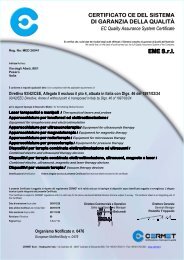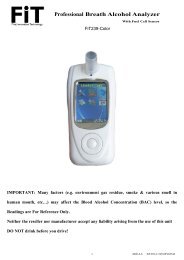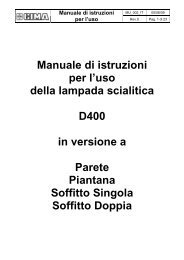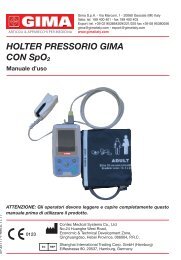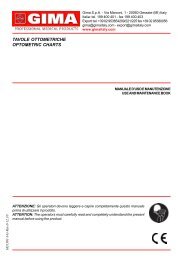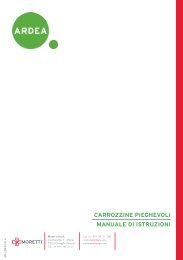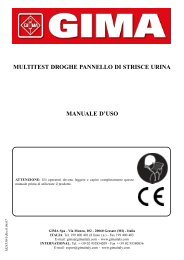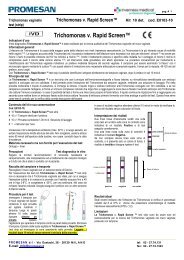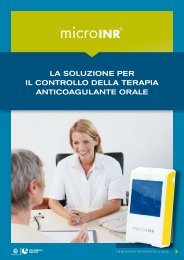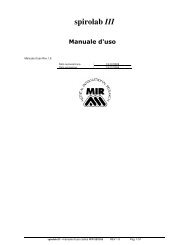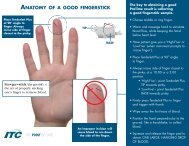test rapido individuazione sangue occulto nelle feci - Doctorshop.it
test rapido individuazione sangue occulto nelle feci - Doctorshop.it
test rapido individuazione sangue occulto nelle feci - Doctorshop.it
Create successful ePaper yourself
Turn your PDF publications into a flip-book with our unique Google optimized e-Paper software.
TEST RAPIDO INDIVIDUZIONE SANGUE OCCULTO NELLE FECI<br />
Leggere le istruzioni con attenzione prima di effettuare il <strong>test</strong>.<br />
PERCHE’ EFFETTUARE IL TEST PER IL SANGUE OCCULTO<br />
NELLE FECI?<br />
Nei loro stadi iniziali le malattie di colon e retto come il cancro, l’ulcera,<br />
le emorroidi, i polipi, la col<strong>it</strong>e, la diverticol<strong>it</strong>e, spesso non mostrano<br />
alcun sintomo evidente, anche se possono provocare la presenza di<br />
tracce nascoste di <strong>sangue</strong> <strong>nelle</strong> <strong>feci</strong>. Il Test controlla proprio la presenza<br />
di queste tracce nascoste ed è quindi utile come primo segnale di<br />
allarme per i problemi in<strong>test</strong>inali che necess<strong>it</strong>ano di controllo e terapia<br />
medica.<br />
CONSERVAZIONE<br />
Tenere il Test a temperatura ambiente (15 - 30°C).<br />
CONTENUTO DELLA CONFEZIONE<br />
Prima di effettuare il <strong>test</strong> assicurarsi che nella confezione siano presenti<br />
5 tessuti di <strong>test</strong> (nella busta grande) ed una bustina per il controllo<br />
pos<strong>it</strong>ivo (busta piccola con croce blu).<br />
TERAPIE E DIETA<br />
Due giorni prima e durante il periodo di esecuzione del <strong>test</strong> ev<strong>it</strong>are<br />
medicine contenenti acido acetilsalicilico, antinfiammatori e unguenti<br />
rettali. Se si sta assumendo una terapia, inclusa l’assunzione di dosi di<br />
ferro, consultare il medico prima di effettuare il <strong>test</strong>.<br />
Non è richiesta una dieta particolare (carne al <strong>sangue</strong> e v<strong>it</strong>amina C<br />
possono essere consumate). Si consiglia comunque di mangiare frutta,<br />
verdura e cereali nei due giorni antecedenti il <strong>test</strong>.<br />
FASI DEL TEST<br />
La procedura per il <strong>test</strong> colon-retto si articola <strong>nelle</strong> tre fasi seguenti:<br />
Fase 1: controllo della qual<strong>it</strong>à dell’acqua.<br />
Fase 2: <strong>test</strong> delle <strong>feci</strong> (in 2 o 3 stadi).<br />
Fase 3: controllo corretta esecuzione del <strong>test</strong> (la busta di controllo<br />
pos<strong>it</strong>ivo viene utilizzata in questa fase).<br />
PREPARAZIONE PER IL TEST<br />
Rimuovere eventuali detergenti, disinfettanti o deodoranti presenti nella<br />
tazza del WC. Fare scorrere l’acqua all’interno del WC diverse volte<br />
prima di effettuare il <strong>test</strong>. Se si dovesse soffrire di difetti visivi di<br />
importante ent<strong>it</strong>à o si dovesse essere affetti da daltonismo, è preferibile<br />
fare leggere i risultati del <strong>test</strong> ad un’altra persona.<br />
PRECAUZIONI<br />
- Non effettuare il <strong>test</strong> nel periodo mestruale, o in presenza di emorroidi<br />
sanguinanti o in caso di st<strong>it</strong>ichezza.<br />
- Tenere i tessuti di <strong>test</strong> non utilizzati nella loro busta a temperatura<br />
ambiente e proteggerli dalla luce diretta del sole e dall’umid<strong>it</strong>à.<br />
- Non ingerire e non inalare il contenuto delle varie buste del<br />
<strong>test</strong>. Tenere lontano dalla portata dei bambini.<br />
ESECUZIONE DEL TEST<br />
Fase 1 - Controllo della qual<strong>it</strong>à dell’acqua:<br />
Aprire la busta grande tagliando lungo la linea<br />
tratteggiata. Estrarre dalla busta un tessuto di <strong>test</strong><br />
e farlo galleggiare sull’acqua del WC. Attendere<br />
2 minuti. NON si dovrebbe vedere un colore bluverde<br />
sul tessuto, se tale colore appare, non<br />
passare alla Fase 2 ma aspettare alcuni giorni<br />
per ripetere il controllo dell'acqua. In questo<br />
caso, effettuare eventualmente due soli <strong>test</strong><br />
delle <strong>feci</strong> (Fase 2) anzichè tre. (Vedere la<br />
sezione “DOMANDE E RISPOSTE”).<br />
Fase 2 - Test delle <strong>feci</strong>: Se necessario urinare<br />
precedentemente, sciacquare quindi il WC.<br />
a. Defecare e non fare correre l’acqua del WC.<br />
b. Estrarre un altro tessuto di <strong>test</strong> dalla busta e<br />
farlo galleggiare sull’acqua del WC. Il <strong>test</strong><br />
funziona correttamente anche se il tessuto<br />
non tocca le <strong>feci</strong>. Piegare e chiudere la parte<br />
aperta della busta per proteggere dall’umid<strong>it</strong>à i<br />
tessuti rimanenti.<br />
c. Passati 2 minuti, controllare se è comparso un<br />
colore blu-verde sull’area di <strong>test</strong> del tessuto<br />
(risultato pos<strong>it</strong>ivo) ed annotare il risultato nella<br />
tabella in fondo a queste istruzioni.<br />
d. Sciacquare il WC.<br />
e. Per effettuare la seconda ed eventuale terza defecazione di controllo,<br />
ripetere i punti della Fase 2, da "a" a "d" e passare poi alla Fase 3.<br />
Fase 3 - Controllo corretta esecuzione del <strong>test</strong> (busta di controllo<br />
pos<strong>it</strong>ivo): Questa prova viene segu<strong>it</strong>a per verificare la valid<strong>it</strong>à del <strong>test</strong>.<br />
Sciacquare il WC e strappando con cura la busta del controllo pos<strong>it</strong>ivo<br />
(busta piccola), spargerne il contenuto nel WC. Attendere un minuto e<br />
mettere un tessuto di <strong>test</strong> nel WC. Dopo due minuti, dovrebbe apparire<br />
sul tessuto una croce di colore blu-verde che indica che i risultati del<br />
<strong>test</strong> effettuati in precedenza sono validi. Lavarsi le mani.<br />
SIGNIFICATO DEI RISULTATI DEL TEST<br />
Tracce di colore blu-verde sull’area di <strong>test</strong> indicano che potrebbe essere<br />
presente del <strong>sangue</strong> <strong>nelle</strong> <strong>feci</strong> (il risultato è pos<strong>it</strong>ivo) e ciò significa che<br />
è raccomandabile consultare il proprio medico per una verifica.<br />
Un risultato pos<strong>it</strong>ivo non significa con certezza che esiste un problema<br />
poichè, diverse condizioni, come ad esempio certe medicine possono<br />
causare un risultato falsato. Se non si è riscontrato il colore blu-verde<br />
(risultato negativo) ciò indica che nel momento in cui si è esegu<strong>it</strong>o il<br />
<strong>test</strong> non era presente <strong>sangue</strong> <strong>nelle</strong> <strong>feci</strong> ma in caso di dubbi o<br />
sintomatologie, è comunque sempre necessario consultare il medico<br />
curante ricordando che in alcuni casi non si verifica il sanguinamento<br />
continuo.<br />
Se il <strong>test</strong> è risultato negativo ma si percepiscono malesseri o<br />
sintomatologie come, ad esempio, quelle di segu<strong>it</strong>o descr<strong>it</strong>te, si<br />
raccomanda di consultare il proprio medico:<br />
1. Diarrea o st<strong>it</strong>ichezza prolungate;<br />
2. Perd<strong>it</strong>a di peso inspiegabile;<br />
3. Sangue visibile <strong>nelle</strong> <strong>feci</strong>;<br />
4. Feci scure o nere.<br />
ATTENZIONE<br />
Questo è un <strong>test</strong> <strong>rapido</strong> di autodiagnosi e non deve essere usato per<br />
confermare l’esistenza o meno di condizioni di malattia.<br />
Non sost<strong>it</strong>uisce in alcun modo la colonscopia e la sigmoidoscopia.<br />
Se si hanno sintomi vari è raccomandabile consultare il medico anche<br />
se i risultati del <strong>test</strong> sono stati negativi.<br />
Questo <strong>test</strong> non è stato progettato per il controllo del sanguinamento<br />
delle porzioni gastroin<strong>test</strong>inali superiori.<br />
tessuto <strong>test</strong> in meno. Se il secondo controllo dell’acqua risulta<br />
nuovamente pos<strong>it</strong>ivo, l’acqua del vostro WC è incompatibile con questo<br />
<strong>test</strong>.<br />
Qual è il significato di un colore arancione invece di blu-verde<br />
durante il controllo della corretta esecuzione del <strong>test</strong>?<br />
La polvere del controllo pos<strong>it</strong>ivo sulla superficie dell’acqua non si è<br />
sciolta adeguatamente ed ha causato un’iperreazione con il tessuto di<br />
<strong>test</strong> che si manifesta con un colore arancione - ruggine. In questo<br />
caso il risultato del <strong>test</strong> va considerato corretto.<br />
Il <strong>test</strong> è da considerarsi pos<strong>it</strong>ivo se si evidenzia solo una piccola<br />
macchia di colore blu-verde?<br />
SI. Qualsiasi manifestazione del colore blu-verde nell’area di <strong>test</strong> è da<br />
considerarsi come risultato pos<strong>it</strong>ivo.<br />
ANNOTAZIONE RISULTATI DEI TEST<br />
DATA<br />
ESITO DEL TEST<br />
Postivo<br />
Negativo<br />
0197<br />
Fabbricante<br />
Solo per uso diagnostico<br />
in v<strong>it</strong>ro<br />
Conservare a 15-30° C<br />
Codice prodotto 24531<br />
Non riutilizzare<br />
GIMA Spa<br />
Via Monza, 102 - 20060<br />
Gessate (MI) - Italia<br />
Gima S.p.A. - Via Monza, 102 - 20060 Gessate (MI) Italy<br />
Italia: tel. 199 400 401 - fax 199 400 403<br />
Export: tel. +39 02 953854209/221/225 fax +39 02 95380056<br />
gima@gima<strong>it</strong>aly.com - export@gima<strong>it</strong>aly.com<br />
www.gima<strong>it</strong>aly.com<br />
TEST RAPIDO INDIVIDUAZIONE SANGUE OCCULTO<br />
NELLE FECI<br />
ISTRUZIONI PER L’USO<br />
DOMANDE E RISPOSTE<br />
Perchè si controlla la qual<strong>it</strong>à dell’acqua?<br />
In alcune regioni e in certi periodi l’acqua può contenere sostanze che<br />
interferiscono con il <strong>test</strong> e potrebbero fornire un risultato pos<strong>it</strong>ivo falso.<br />
Che cosa bisogna fare quando il controllo della qual<strong>it</strong>à dell’acqua<br />
ha dato risultato pos<strong>it</strong>ivo (blu-verde)?<br />
Attendere alcuni giorni, preparare il WC come descr<strong>it</strong>to nella sezione<br />
“PREPARAZIONE PER IL TEST” e rifare le operazioni dalla fase 1<br />
effettuando però solo due defecazioni anzichè tre perchè avrete un<br />
M24531-I-G-Rev.5-07.09<br />
ATTENZIONE: Prima di utilizzare il prodotto, leggere<br />
attentamente tutte le istruzioni per una visione completa<br />
dell’esecuzione del <strong>test</strong>.<br />
0197
HOME TEST FOR HIDDEN BLOOD IN THE STOOL<br />
Read precautions before <strong>test</strong>ing<br />
WHY TEST YOURSELF FOR STOOL BLOOD?<br />
In their early stages, colorectal diseases such as cancer, ulcers,<br />
hemorrhoids, polyps, col<strong>it</strong>is, diverticul<strong>it</strong>is, and fissures may not show<br />
any visible symptoms, even though they<br />
may be producing blood hidden in the stool. The <strong>test</strong> can detect this<br />
unseen blood and thereby serves as an early warning signal of bowel<br />
troubles that need medical attention.<br />
STORAGE<br />
Store at room temperature (59° - 86°F / 15° - 30°C).<br />
CONTENTS OF THE TEST KIT<br />
You must account for the following <strong>it</strong>ems before <strong>test</strong>ing.<br />
MEDICATION AND DIET<br />
Two days prior to and during the <strong>test</strong>ing period, avoid aspirin containing<br />
medicines, anti-inflammatory drugs, and rectal ointments. If you are<br />
taking medication, including prescribed doses of iron, check w<strong>it</strong>h your<br />
physician before <strong>test</strong>ing.<br />
No diet restrictions are required (rare meat and V<strong>it</strong>amin C are okay).<br />
However, for two days before and during <strong>test</strong>ing, try to eat vegetables,<br />
fru<strong>it</strong>s, and cereals.<br />
TEST SUMMARY<br />
There are three steps to the EZ DETECT procedure:<br />
Step 1. Water qual<strong>it</strong>y check (one time only).<br />
Step 2. Stool <strong>test</strong> (3 consecutive bowel movements).<br />
Step 3. Test performance (one time only - pos<strong>it</strong>ive control is used here).<br />
PREPARATION FOR THE TEST<br />
Remove all toilet cleaners, disinfectants or deodorizers from the toilet<br />
bowl and tank. Flush the toilet bowl several times before <strong>test</strong>ing. If you<br />
are color blind or visually impaired, have someone else read the results.<br />
PRECAUTIONS<br />
- Do not perform the <strong>test</strong> during menstrual bleeding, bleeding<br />
hemorrhoids, or constipation.<br />
- Store unused <strong>test</strong> tissues at room temperature and protect from<br />
sunlight and moisture.<br />
- Do not ingest or inhale contents of Pos<strong>it</strong>ive Control Package.<br />
Keep out of reach of children.<br />
TEST DIRECTIONS<br />
Step 1. Water Qual<strong>it</strong>y Check: Cut open the large pouch at the dotted<br />
line. Take one <strong>test</strong> tissue out of the pouch. Float the <strong>test</strong> tissue on top<br />
of the toilet water. Wa<strong>it</strong> 2 minutes. You should see no blue-green color<br />
on the <strong>test</strong> tissue. If there is a blue-green color on the <strong>test</strong> tissue, wa<strong>it</strong><br />
three (3) days and repeat Step #1 and skip Step #3.<br />
(See Common Questions section)<br />
Step 2. Stool Test: If necessary, urinate first, then<br />
flush toilet.<br />
a. Have a bowel movement. Do not flush the toilet.<br />
b. Remove another <strong>test</strong> tissue from the pouch and<br />
float <strong>it</strong> onto the toilet water. The <strong>test</strong> tissue does<br />
not need to touch the stool. Fold & close the<br />
opened end of the pouch to protect the remaining<br />
tissues from moisture.<br />
c. W<strong>it</strong>hin 2 minutes, look for a blue-green color<br />
on the <strong>test</strong> area of the <strong>test</strong> tissue. Record the<br />
result on the Test Result Card by marking an<br />
“X” for color or no color.<br />
d. Flush the toilet.<br />
e. For the second and third bowel movements<br />
repeat Step #2 “a” to “d”. This completes the<br />
stool <strong>test</strong>s.<br />
Step 3. Test Performance: This step must be<br />
completed in order for your <strong>test</strong> results to be valid.<br />
Flush the toilet. Carefully tear open the Pos<strong>it</strong>ive<br />
Control Package (small foil pouch) and sprinkle<br />
<strong>it</strong>s contents into the toilet while the water is filling<br />
up in the bowl. Wa<strong>it</strong> one minute, drop the last <strong>test</strong><br />
tissue into the toilet bowl. W<strong>it</strong>hin two minutes, a<br />
blue-green cross should appear on the tissue,<br />
meaning that your <strong>test</strong> tissues have worked<br />
properly. Wash your hands. Record the result on the Test Result Card.<br />
WHAT DOES THE TEST RESULT MEAN?<br />
Any trace of blue-green color visible in the TEST AREA<br />
indicates that blood may be present in your stool (a pos<strong>it</strong>ive <strong>test</strong> result)<br />
meaning that there is a possible cond<strong>it</strong>ion requiring your physician’s<br />
attention.<br />
A pos<strong>it</strong>ive <strong>test</strong> result does not always mean that a problem exists, e.g.<br />
certain medicines can cause a false result as previously mentioned.<br />
No trace of a blue-green color in the cross indicates that at the time of<br />
your <strong>test</strong> there was no detectable blood in the stool. However, some<br />
cond<strong>it</strong>ions may not cause bleeding all the time.<br />
If you have a negative <strong>test</strong>, but have one or more of the<br />
following symptoms, consult your physician:<br />
1. Diarrhea or constipation lasting longer than two weeks<br />
2. Unexplained weight loss<br />
3. Visible blood in the stool<br />
4. Dark black stool<br />
WARNING<br />
This is a screening <strong>test</strong> and should not be used to confirm the existence<br />
or absence of any disease cond<strong>it</strong>ion. It is not a replacement for<br />
colonoscopy or sigmoidoscopy. If you have any symptoms that concern<br />
you consult your physician - even if your <strong>test</strong> results are negative.<br />
This <strong>test</strong> is not designed as a <strong>test</strong> for upper gastroin<strong>test</strong>inal bleeding.<br />
COMMON QUESTIONS<br />
Q. Why <strong>test</strong> for water qual<strong>it</strong>y?<br />
A. In some regions or on certain days the water may contain substances<br />
that interfere w<strong>it</strong>h this <strong>test</strong> and one could get false pos<strong>it</strong>ive result.<br />
Q. Is the stool <strong>test</strong> “pos<strong>it</strong>ive” when there is only a small speck<br />
of blue-green color on the <strong>test</strong> area?<br />
A. Yes. Any visible blue-green color in the <strong>test</strong> area is considered a<br />
“pos<strong>it</strong>ive” result.<br />
TEST RESULTS<br />
DATE<br />
TEST RESULT<br />
Postive<br />
Negative<br />
0197<br />
For in v<strong>it</strong>ro use only<br />
Store between 15-30° C<br />
Product code 24531<br />
Do not reuse<br />
Gima S.p.A. - Via Monza, 102 - 20060 Gessate (MI) Italy<br />
Italia: tel. 199 400 401 - fax 199 400 403<br />
Export: tel. +39 02 953854209/221/225 fax +39 02 95380056<br />
gima@gima<strong>it</strong>aly.com - export@gima<strong>it</strong>aly.com<br />
www.gima<strong>it</strong>aly.com<br />
HOME TEST FOR HIDDEN BLOOD IN THE STOOL<br />
Q. What do I do when the Water Qual<strong>it</strong>y Check is pos<strong>it</strong>ive (bluegreen)?<br />
A. Wa<strong>it</strong> 3 days, prepare the toilet as in the “Preparation For The Test”<br />
section and redo the <strong>test</strong> from Step #1, but skip Step #3 since you<br />
have one less <strong>test</strong> tissue. If the water check is again pos<strong>it</strong>ive,the water<br />
in your toilet is unsu<strong>it</strong>able for this <strong>test</strong>.<br />
Manufacturer<br />
GIMA Spa<br />
Via Monza, 102 - 20060<br />
Gessate (MI) - Italia<br />
ATTENTION: The operators must carefully read and<br />
completely understand the present manual before using the<br />
product.<br />
USER MANUAL<br />
Q. What does <strong>it</strong> mean when the result of the Test Performance<br />
is orange instead of blue-green?<br />
A. The Pos<strong>it</strong>ive Control powder on the surface of the water is not<br />
completely dissolved and causes an overreaction w<strong>it</strong>h the <strong>test</strong> tissue.<br />
The overreaction appears as an orange or rust color. In this case the<br />
<strong>test</strong> result is considered “pos<strong>it</strong>ive”.<br />
M24531-I-G-Rev.5-07.09<br />
0197



